Strategic Ground Data Planning for Efficient Crop Classification Using Remote Sensing and Mobile-Based Survey Tools
Abstract
1. Introduction
2. Materials and Methods
2.1. Study Area
2.2. Methodology
2.3. Ground Data Planning and Field Collection
2.4. Crop Classification Using Supervised Classification
3. Results
3.1. Spectral Clustering and Ground Truth Sampling
3.2. Crop Classification Using Random Forest Classifier
4. Discussion
5. Conclusions
Author Contributions
Funding
Data Availability Statement
Acknowledgments
Conflicts of Interest
References
- Im, J. Earth observations and geographic information science for sustainable development goals. GIScience Remote Sens. 2020, 57, 591–592. [Google Scholar] [CrossRef]
- Obi Reddy, G.; Dwivedi, B.; Ravindra Chary, G. Applications of geospatial and big data technologies in smart farming. In Smart Agriculture for Developing Nations: Status, Perspectives and Challenges; Springer: Berlin/Heidelberg, Germany, 2023; pp. 15–31. [Google Scholar]
- Weiss, M.; Jacob, F.; Duveiller, G. Remote sensing for agricultural applications: A meta-review. Remote Sens. Environ. 2020, 236, 111402. [Google Scholar] [CrossRef]
- Lobell, D.B.; Asner, G.P.; Ortiz-Monasterio, J.I.; Benning, T.L. Remote sensing of regional crop production in the Yaqui Valley, Mexico: Estimates and uncertainties. Agric. Ecosyst. Environ. 2003, 94, 205–220. [Google Scholar] [CrossRef]
- Jha, P.K.; Middendorf, G.; Faye, A.; Middendorf, B.J.; Prasad, P.V. Lives and livelihoods in smallholder farming systems of senegal: Impacts, adaptation, and resilience to COVID-19. Land 2023, 12, 178. [Google Scholar] [CrossRef]
- Anderson, M.C.; Allen, R.G.; Morse, A.; Kustas, W.P. Use of Landsat thermal imagery in monitoring evapotranspiration and managing water resources. Remote Sens. Environ. 2012, 122, 50–65. [Google Scholar] [CrossRef]
- Qiu, B.; Hu, X.; Chen, C.; Tang, Z.; Yang, P.; Zhu, X.; Yan, C.; Jian, Z. Maps of cropping patterns in China during 2015–2021. Sci. Data 2022, 9, 479. [Google Scholar] [CrossRef] [PubMed]
- Dong, J.; Xiao, X.; Kou, W.; Qin, Y.; Zhang, G.; Li, L.; Jin, C.; Zhou, Y.; Wang, J.; Biradar, C. Tracking the dynamics of paddy rice planting area in 1986–2010 through time series Landsat images and phenology-based algorithms. Remote Sens. Environ. 2015, 160, 99–113. [Google Scholar] [CrossRef]
- Pittman, K.; Hansen, M.C.; Becker-Reshef, I.; Potapov, P.V.; Justice, C.O. Estimating global cropland extent with multi-year MODIS data. Remote Sens. 2010, 2, 1844–1863. [Google Scholar] [CrossRef]
- Tateishi, R.; Hoan, N.T.; Kobayashi, T.; Alsaaideh, B.; Tana, G.; Phong, D.X. Production of global land cover data-GLCNMO2008. J. Geogr. Geol. 2014, 6, 99. [Google Scholar] [CrossRef]
- Thenkabail, P.S.; Teluguntla, P.G.; Xiong, J.; Oliphant, A.; Congalton, R.G.; Ozdogan, M.; Gumma, M.K.; Tilton, J.C.; Giri, C.; Milesi, C. Global Cropland-Extent Product at 30-m Resolution (GCEP30) Derived from Landsat Satellite Time-Series Data for the Year 2015 Using Multiple MACHINE-learning Algorithms on Google Earth Engine Cloud; US Geological Survey: Moffett Field, CA, USA, 2021; ISSN 2330-7102. [Google Scholar]
- Gray, J.; Friedl, M.; Frolking, S.; Ramankutty, N.; Nelson, A.; Gumma, M.K. Mapping Asian cropping intensity with MODIS. IEEE J. Sel. Top. Appl. Earth Obs. Remote Sens. 2014, 7, 3373–3379. [Google Scholar] [CrossRef]
- Salcedo-Sanz, S.; Ghamisi, P.; Piles, M.; Werner, M.; Cuadra, L.; Moreno-Martínez, A.; Izquierdo-Verdiguier, E.; Muñoz-Marí, J.; Mosavi, A.; Camps-Valls, G. Machine learning information fusion in Earth observation: A comprehensive review of methods, applications and data sources. Inf. Fusion 2020, 63, 256–272. [Google Scholar] [CrossRef]
- Panjala, P.; Gumma, M.K.; Teluguntla, P. Machine learning approaches and sentinel-2 data in crop type mapping. In Data Science in Agriculture and Natural Resource Management; Springer: Singapore, 2022; pp. 161–180. [Google Scholar]
- Phalke, A.; Ozdogan, M.; Thenkabail, P.; Erickson, T.; Gorelick, N. Mapping croplands of Europe, Middle East, Russia, and Central Asia using Landsat 30-m data, machine learning algorithms and Google Earth Engine. ISPRS J. Photogramm. Remote Sens. 2020, 167, 104–122. [Google Scholar] [CrossRef]
- Gumma, M.K.; Panjala, P.; Dubey, S.K.; Ray, D.K.; Murthy, C.; Kadiyala, D.M.; Mohammed, I.; Takashi, Y. Spatial Distribution of Cropping Systems in South Asia Using Time-Series Satellite Data Enriched with Ground Data. Remote Sens. 2024, 16, 2733. [Google Scholar] [CrossRef]
- Johnson, D.M.; Mueller, R. Pre-and within-season crop type classification trained with archival land cover information. Remote Sens. Environ. 2021, 264, 112576. [Google Scholar] [CrossRef]
- Hussain, S.; Qin, S.; Nasim, W.; Bukhari, M.A.; Mubeen, M.; Fahad, S.; Raza, A.; Abdo, H.G.; Tariq, A.; Mousa, B. Monitoring the dynamic changes in vegetation cover using spatio-temporal remote sensing data from 1984 to 2020. Atmosphere 2022, 13, 1609. [Google Scholar] [CrossRef]
- Foerster, S.; Kaden, K.; Foerster, M.; Itzerott, S. Crop type mapping using spectral–temporal profiles and phenological information. Comput. Electron. Agric. 2012, 89, 30–40. [Google Scholar] [CrossRef]
- Chunfang, Y.; Xing, J.; Changming, C.; Shiou, L.; Obuobi, B.; Yifeng, Z. Digital economy empowers sustainable agriculture: Implications for farmers’ adoption of ecological agricultural technologies. Ecol. Indic. 2024, 159, 111723. [Google Scholar] [CrossRef]
- Mathenge, M.; Sonneveld, B.G.; Broerse, J.E. Application of GIS in agriculture in promoting evidence-informed decision making for improving agriculture sustainability: A systematic review. Sustainability 2022, 14, 9974. [Google Scholar] [CrossRef]
- Raihan, A. A systematic review of Geographic Information Systems (GIS) in agriculture for evidence-based decision making and sustainability. Glob. Sustain. Res. 2024, 3, 1–24. [Google Scholar] [CrossRef]
- Hu, L.; Zhang, C.; Zhang, M.; Shi, Y.; Lu, J.; Fang, Z. Enhancing FAIR data services in agricultural disaster: A review. Remote Sens. 2023, 15, 2024. [Google Scholar] [CrossRef]
- Chakraborty, A.; Biswal, A.; Pandey, V.; Shadab, S.; Kalyandeep, K.; Murthy, C.; Seshasai, M.; Rao, P.; Jain, N.; Sehgal, V. Developing a spatial information system of biomass potential from crop residues over India: A decision support for planning and establishment of biofuel/biomass power plant. Renew. Sustain. Energy Rev. 2022, 165, 112575. [Google Scholar] [CrossRef]
- Benti, N.E.; Chaka, M.D.; Semie, A.G.; Warkineh, B.; Soromessa, T. Transforming agriculture with Machine Learning, Deep Learning, and IoT: Perspectives from Ethiopia—Challenges and opportunities. Discov. Agric. 2024, 2, 63. [Google Scholar] [CrossRef]
- Rashid, M.R.A.; Hasan, M.; Islam, M.A.; Tasnim, S.T.; Taifa, R.J.; Mahbub, S.; Mansoor, N.; Ali, M.S.; Jabid, T.; Islam, M. Transforming agri-food value chains in Bangladesh: A practical application of blockchain for traceability and fair pricing. Heliyon 2024, 10, e40091. [Google Scholar] [CrossRef] [PubMed]
- Sizan, N.S.; Layek, M.A.; Hasan, K.F. A secured triad of IoT, machine learning, and blockchain for crop forecasting in agriculture. arXiv 2025, arXiv:2505.01196. [Google Scholar] [CrossRef]
- Singh, A.; Jadhav, A.; Singh, P. AI Applications in Production. In Industry 4.0, Smart Manufacturing, and Industrial Engineering; CRC Press: Boca Raton, FL, USA, 2024; pp. 139–161. [Google Scholar]
- Hofmann, E.; Selensky, S.; Kirstätter, N. Emerging technologies and supply chain management: Maneuvering in current areas of tensions. In Industry 4.0; CRC Press: Boca Raton, FL, USA, 2020; pp. 1–42. [Google Scholar]
- Kour, V.P.; Arora, S. Recent developments of the internet of things in agriculture: A survey. IEEE Access 2020, 8, 129924–129957. [Google Scholar] [CrossRef]
- Laamrani, A.; Pardo Lara, R.; Berg, A.A.; Branson, D.; Joosse, P. Using a mobile device “app” and proximal remote sensing technologies to assess soil cover fractions on agricultural fields. Sensors 2018, 18, 708. [Google Scholar] [CrossRef]
- Dhal, S.; Wyatt, B.M.; Mahanta, S.; Bhattarai, N.; Sharma, S.; Rout, T.; Saud, P.; Acharya, B.S. Internet of Things (IoT) in digital agriculture: An overview. Agron. J. 2024, 116, 1144–1163. [Google Scholar] [CrossRef]
- Tonnang, H.E.; Salifu, D.; Mudereri, B.T.; Tanui, J.; Espira, A.; Dubois, T.; Abdel-Rahman, E.M. Advances in data-collection tools and analytics for crop pest and disease management. Curr. Opin. Insect Sci. 2022, 54, 100964. [Google Scholar] [CrossRef]
- Taye, M.; Azeze, T.; Hunde, D.; Melese, K.; Hassen, A.; Mihreteab, S.; Assefa, G.; Yilma, Z. Challenges and opportunities of tablet-based electronic performance data collection and feedback system for artificial insemination delivery in dairy cattle: Experience from the land O’Lakes Venture37 PAID project in Ethiopia. Cogent Food Agric. 2023, 9, 2202217. [Google Scholar] [CrossRef]
- Templ, B. A roadmap for advancing plant phenological studies through effective open research data management. Ecol. Inform. 2025, 87, 103109. [Google Scholar] [CrossRef]
- Penki, R.; Meesala, S.B.; Tanniru, S. A review of challenges and solutions in adopting a participatory geographical information system for disaster management. Ecocycles 2022, 8, 64–73. [Google Scholar] [CrossRef]
- Lush, V.; Bastin, L.; Otsu, K.; Masó, J. Assessing FAIRness of citizen science data in the context of the Green Deal Data Space. Int. J. Digit. Earth 2024, 17, 2344587. [Google Scholar] [CrossRef]
- Gumma, M.K.; Nelson, A.; Thenkabail, P.S.; Singh, A.N. Mapping rice areas of South Asia using MODIS multitemporal data. J. Appl. Remote Sens. 2011, 5, 053547. [Google Scholar] [CrossRef]
- Thenkabail, P.; GangadharaRao, P.; Biggs, T.; Krishna, M.; Turral, H. Spectral Matching Techniques to Determine Historical Land-use/Land-cover (LULC) and Irrigated Areas Using Time-series 0.1-degree AVHRR Pathfinder Datasets. Photogramm. Eng. Remote Sens. 2007, 73, 1029–1040. [Google Scholar]
- Gumma, M.K.; Tummala, K.; Dixit, S.; Collivignarelli, F.; Holecz, F.; Kolli, R.N.; Whitbread, A.M. Crop type identification and spatial mapping using Sentinel-2 satellite data with focus on field-level information. Geocarto Int. 2022, 37, 1833–1849. [Google Scholar] [CrossRef]
- Rao, P.; Zhou, W.; Bhattarai, N.; Srivastava, A.K.; Singh, B.; Poonia, S.; Lobell, D.B.; Jain, M. Using Sentinel-1, Sentinel-2, and Planet imagery to map crop type of smallholder farms. Remote Sens. 2021, 13, 1870. [Google Scholar] [CrossRef]
- Russell, A.M.; Browne, M.; Hing, N.; Rockloff, M.; Newall, P. Are any samples representative or unbiased? Reply to Pickering and Blaszczynski. Int. Gambl. Stud. 2022, 22, 102–113. [Google Scholar] [CrossRef]
- Gao, Z.; Guo, D.; Ryu, D.; Western, A.W. Training sample selection for robust multi-year within-season crop classification using machine learning. Comput. Electron. Agric. 2023, 210, 107927. [Google Scholar] [CrossRef]
- Zheng, Y.-Y.; Kong, J.-L.; Jin, X.-B.; Wang, X.-Y.; Su, T.-L.; Zuo, M. CropDeep: The crop vision dataset for deep-learning-based classification and detection in precision agriculture. Sensors 2019, 19, 1058. [Google Scholar] [CrossRef]
- Tariq, A.; Yan, J.; Gagnon, A.S.; Riaz Khan, M.; Mumtaz, F. Mapping of cropland, cropping patterns and crop types by combining optical remote sensing images with decision tree classifier and random forest. Geo-Spat. Inf. Sci. 2023, 26, 302–320. [Google Scholar] [CrossRef]
- Lou, C.; Al-qaness, M.A.; AL-Alimi, D.; Dahou, A.; Abd Elaziz, M.; Abualigah, L.; Ewees, A.A. Land use/land cover (LULC) classification using hyperspectral images: A review. Geo-Spat. Inf. Sci. 2025, 28, 345–386. [Google Scholar] [CrossRef]
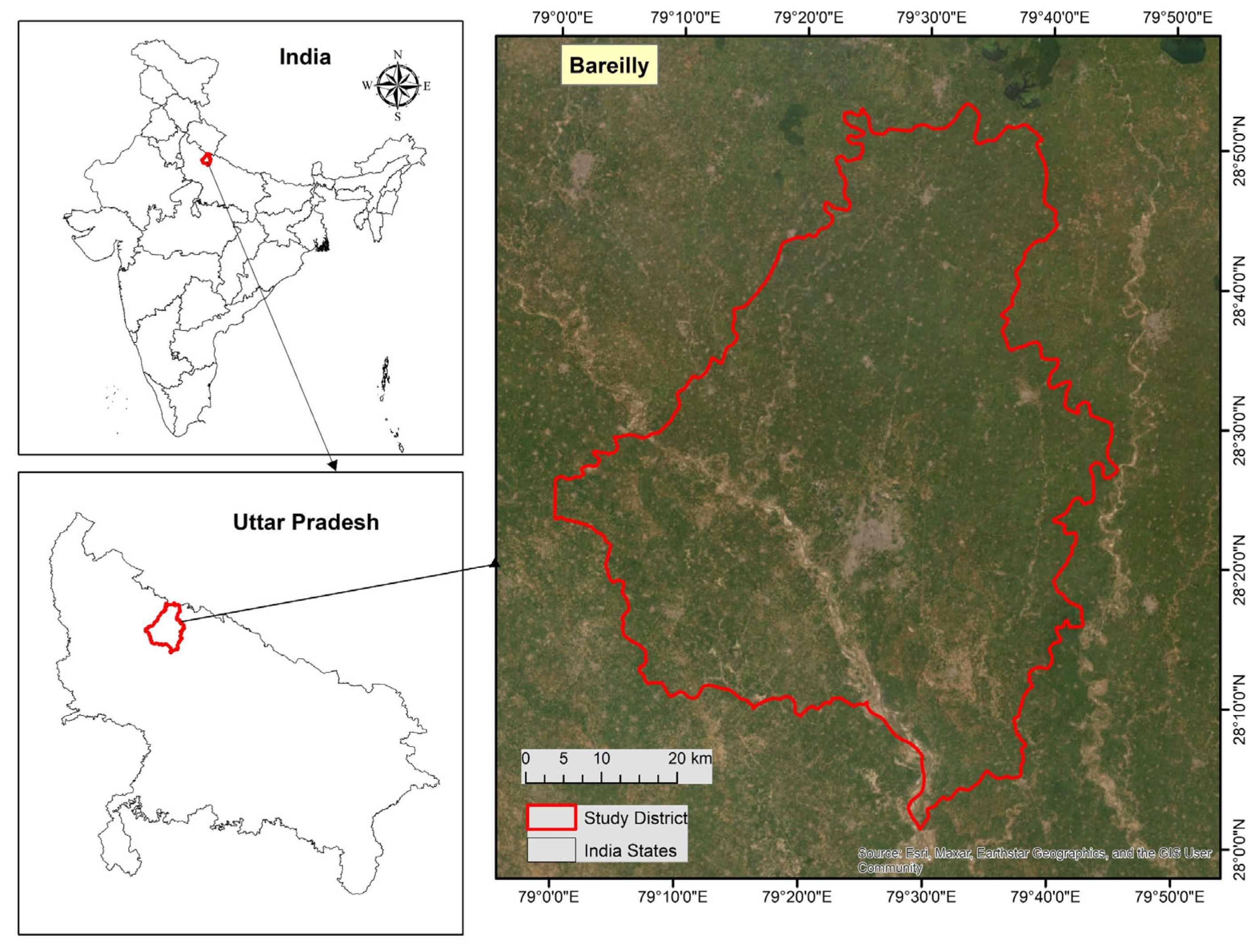
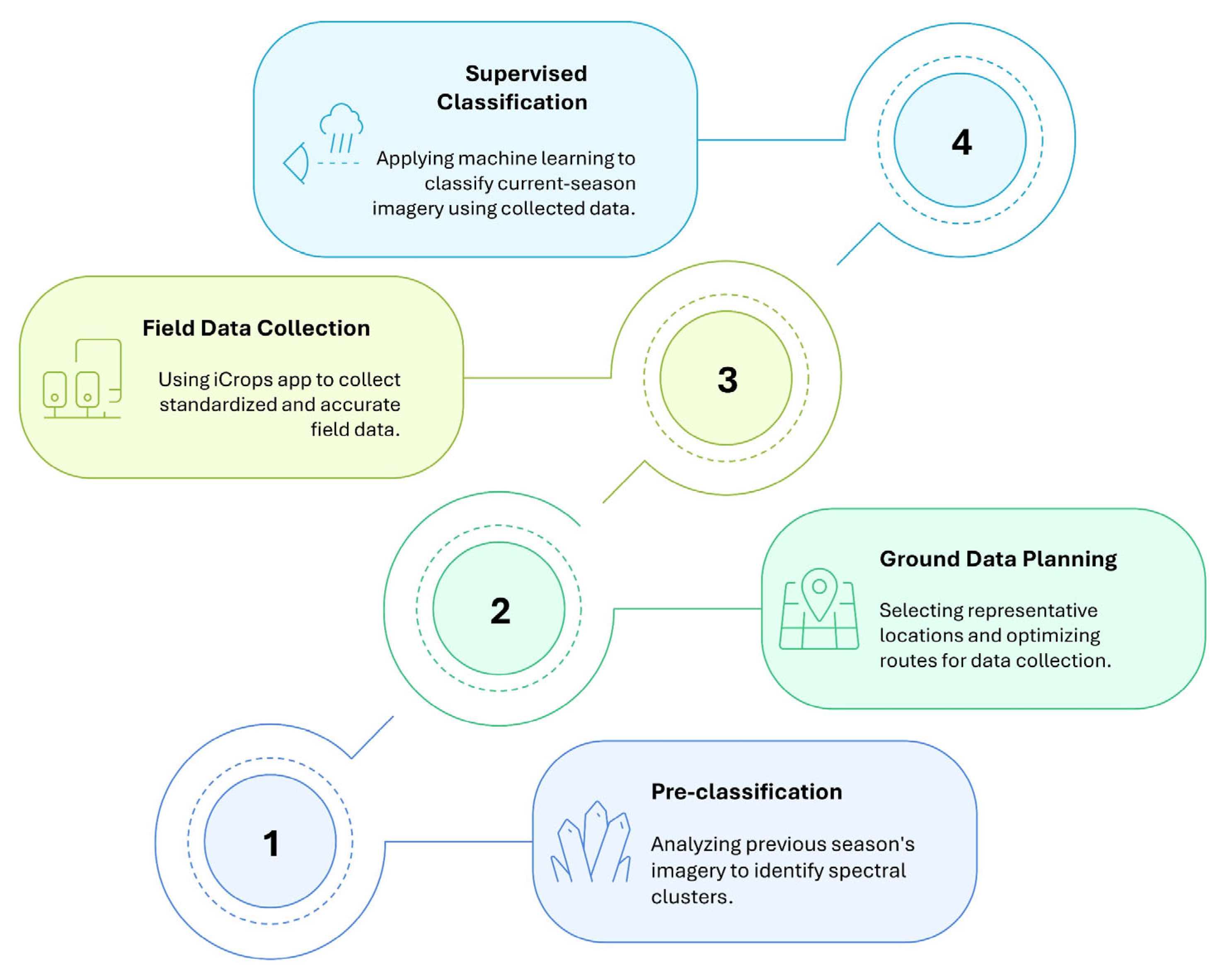
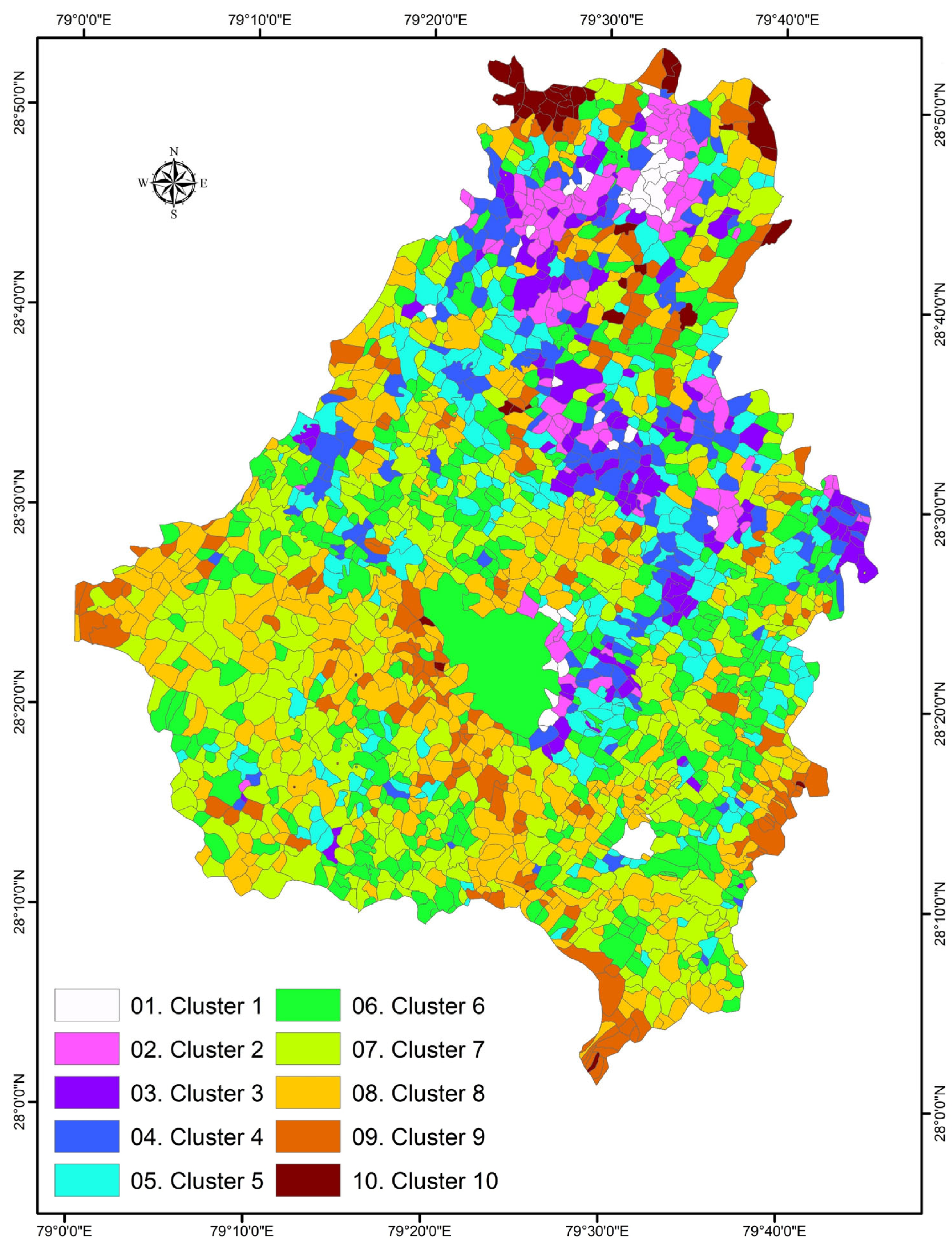
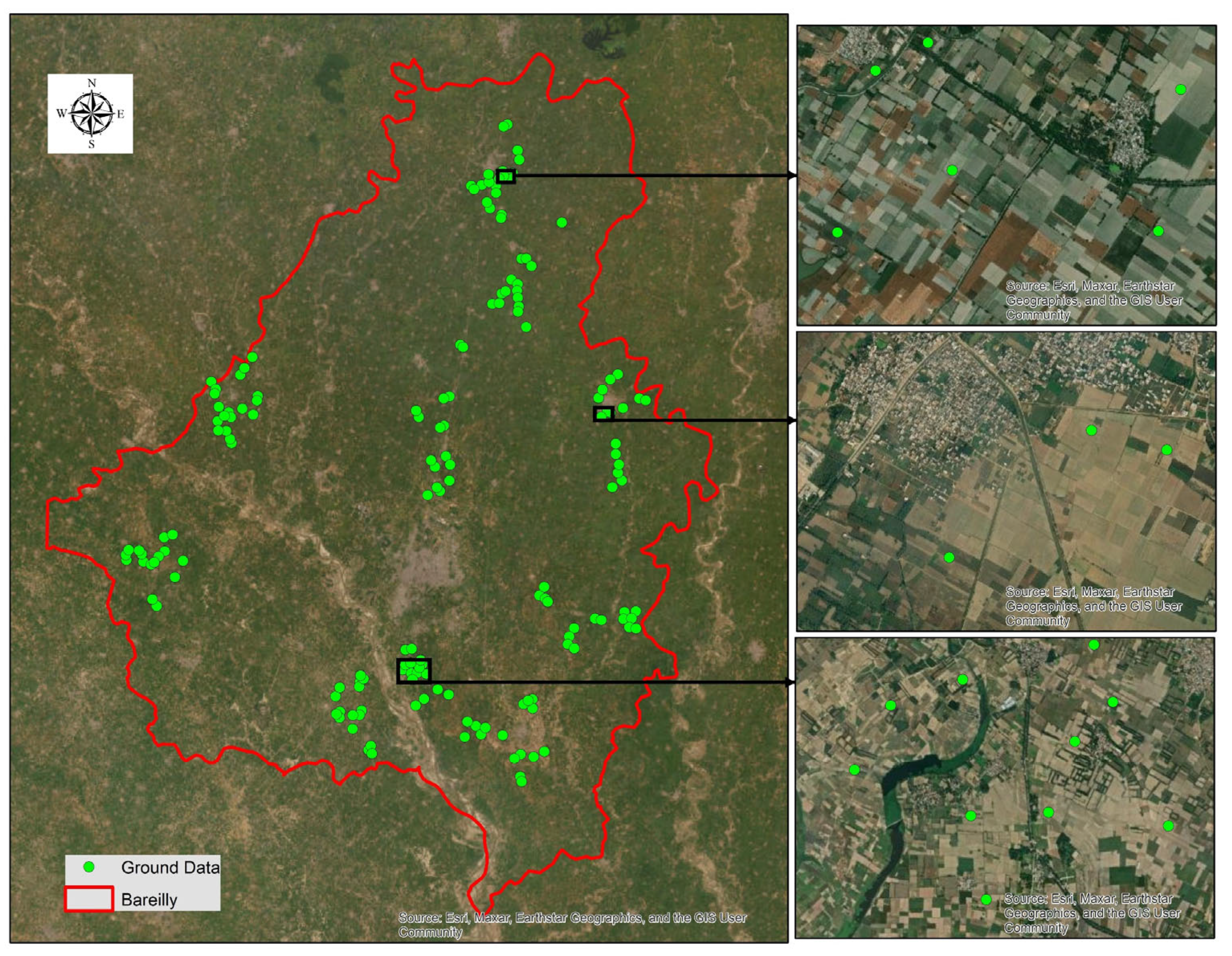

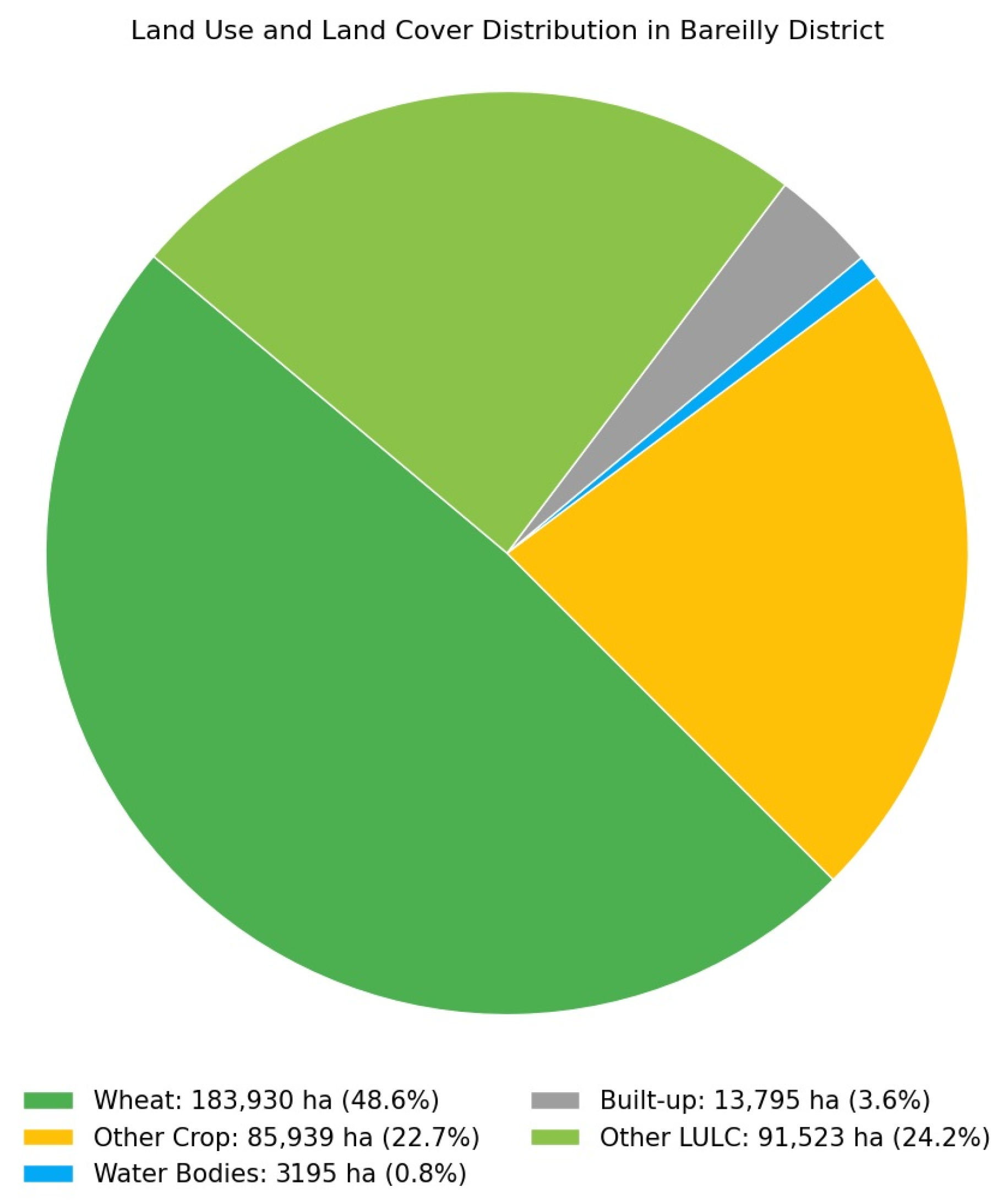
| Spectral Cluster | Associated LULC Class | Total Ground Points |
|---|---|---|
| Cluster 1 | Wheat | 30 |
| Cluster 2 | Other Crop | 18 |
| Cluster 3 | Water Bodies | 12 |
| Cluster 4 | Built-up | 14 |
| Cluster 5 | Wheat | 20 |
| Cluster 6 | Other LULC | 4 |
| Cluster 7 | Other Crop | 25 |
| Cluster 8 | Other Crop | 15 |
| Cluster 9 | Wheat | 28 |
| Cluster 10 | Other LULC | 31 |
| Total | 197 | |
| Reference/GT | Wheat | Other Crop | Water Bodies | Built-Up | Other LULC | Total | User’s Accuracy (%) |
|---|---|---|---|---|---|---|---|
| Wheat | 26 | 1 | 0 | 0 | 0 | 27 | 96 |
| Other Crop | 1 | 10 | 0 | 1 | 0 | 12 | 83 |
| Water Bodies | 0 | 0 | 4 | 0 | 0 | 4 | 100 |
| Built-up | 0 | 0 | 0 | 5 | 1 | 6 | 83 |
| Other LULC | 0 | 0 | 0 | 0 | 10 | 11 | 91 |
| Total | 27 | 11 | 4 | 6 | 11 | 60 | |
| Producer’s (%) | 96 | 91 | 100 | 83 | 91 |
Disclaimer/Publisher’s Note: The statements, opinions and data contained in all publications are solely those of the individual author(s) and contributor(s) and not of MDPI and/or the editor(s). MDPI and/or the editor(s) disclaim responsibility for any injury to people or property resulting from any ideas, methods, instructions or products referred to in the content. |
© 2025 by the authors. Licensee MDPI, Basel, Switzerland. This article is an open access article distributed under the terms and conditions of the Creative Commons Attribution (CC BY) license (https://creativecommons.org/licenses/by/4.0/).
Share and Cite
Nukala, R.M.; Panjala, P.; Mahammood, V.; Gumma, M.K. Strategic Ground Data Planning for Efficient Crop Classification Using Remote Sensing and Mobile-Based Survey Tools. Geographies 2025, 5, 59. https://doi.org/10.3390/geographies5040059
Nukala RM, Panjala P, Mahammood V, Gumma MK. Strategic Ground Data Planning for Efficient Crop Classification Using Remote Sensing and Mobile-Based Survey Tools. Geographies. 2025; 5(4):59. https://doi.org/10.3390/geographies5040059
Chicago/Turabian StyleNukala, Ramavenkata Mahesh, Pranay Panjala, Vazeer Mahammood, and Murali Krishna Gumma. 2025. "Strategic Ground Data Planning for Efficient Crop Classification Using Remote Sensing and Mobile-Based Survey Tools" Geographies 5, no. 4: 59. https://doi.org/10.3390/geographies5040059
APA StyleNukala, R. M., Panjala, P., Mahammood, V., & Gumma, M. K. (2025). Strategic Ground Data Planning for Efficient Crop Classification Using Remote Sensing and Mobile-Based Survey Tools. Geographies, 5(4), 59. https://doi.org/10.3390/geographies5040059









